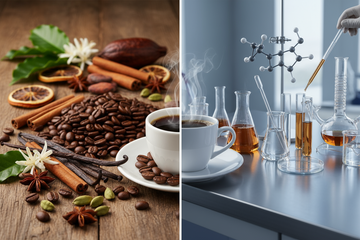Understanding the difference between natural and artificial coffee flavorings can transform your coffee experience. Learn what goes into your favorite flavored brews and how to make informed choices for better taste and quality.
Every morning, millions of coffee lovers reach for their favorite flavored brew, whether it's vanilla, caramel, hazelnut, or something more exotic. But have you ever wondered what creates those enticing flavors in your cup? The world of coffee flavoring is more complex than most people realize, with a significant distinction between natural and artificial flavoring methods that can dramatically impact both taste and quality.
Understanding Natural Coffee Flavoring
Natural coffee flavoring derives from real ingredients found in nature. These flavorings come from actual vanilla beans, cacao pods, fruit extracts, spices, nuts, and botanical sources. When coffee roasters use natural flavoring methods, they're incorporating genuine ingredients that have been processed to concentrate their flavor compounds.
The process of creating natural coffee flavors often involves extracting essential oils, essences, and aromatic compounds directly from their source materials. For instance, natural vanilla flavoring comes from vanilla bean pods, where the vanillin and other flavor compounds are carefully extracted and concentrated. Similarly, natural caramel flavoring might be created through the controlled heating of natural sugars until they develop those rich, complex caramel notes.
Natural flavoring methods also include infusing coffee beans during or after the roasting process with these extracted compounds. Some roasters prefer to add natural flavor oils while the beans are still warm from roasting, allowing the flavors to penetrate the bean structure more effectively. This timing creates a more integrated flavor profile where the added tastes complement rather than mask the coffee's inherent characteristics.
The Science Behind Artificial Coffee Flavoring
Artificial coffee flavoring takes a different approach, using synthetic compounds created in laboratories to mimic natural flavors. These synthetic molecules are designed to replicate the taste and aroma profiles of natural ingredients, often achieving remarkably similar sensory experiences at a fraction of the cost.
The most common artificial flavoring compounds used in coffee include synthetic vanillin, ethyl butyrate for fruity notes, and various aldehyde compounds for nutty or caramel-like flavors. These synthetic molecules are chemically identical or very similar to their natural counterparts, which explains why artificial flavors can taste so convincing.
Artificial flavoring offers several advantages for commercial coffee production. These synthetic compounds provide consistent flavor profiles batch after batch, resist degradation during storage, and cost significantly less than natural alternatives. For large-scale coffee operations, artificial flavoring ensures that every bag of hazelnut coffee tastes exactly the same, regardless of seasonal variations or supply chain disruptions that might affect natural ingredients.
Taste Profile Differences
The sensory experience between naturally and artificially flavored coffee reveals subtle but important differences that discerning coffee drinkers often notice. Natural flavoring tends to create more complex, layered taste profiles with subtle variations and depth. These flavors often develop and change as you drink, revealing different notes as the coffee cools or as your palate adjusts.
Natural vanilla-flavored coffee, for example, might present initial sweet notes followed by subtle spicy undertones and a warm, creamy finish. The complexity comes from the hundreds of different compounds present in real vanilla beans, each contributing to the overall flavor experience in unique ways.
Artificial flavoring, while often more intense and immediately recognizable, typically presents a more straightforward flavor profile. Artificially flavored coffee tends to taste consistent from the first sip to the last, with less complexity but often greater intensity. Some coffee drinkers prefer this consistency and boldness, especially when they want a specific flavor experience without surprises.
The interaction between flavoring and coffee's natural taste also differs significantly. Natural flavoring tends to complement and enhance coffee's inherent flavors, creating harmony between the added tastes and the coffee's natural chocolate, nutty, or fruity notes. Artificial flavoring can sometimes compete with or overshadow these natural coffee characteristics, creating a more dominant flavor presence.
Health and Quality Considerations
From a health perspective, both natural and artificial coffee flavorings are generally recognized as safe when used in appropriate quantities. However, there are some considerations worth understanding for health-conscious coffee drinkers.
Natural flavoring often contains fewer additives and preservatives, as the natural compounds themselves tend to be more stable and require less chemical intervention to maintain their integrity. Many natural flavoring processes also avoid the use of synthetic solvents or chemical extraction methods that some consumers prefer to minimize in their diets.
Artificial flavoring may contain additional stabilizers, preservatives, or carrier compounds that help maintain flavor consistency and shelf life. While these additives are regulated and considered safe, some individuals with sensitivities or those following specific dietary protocols may prefer to avoid them.
The quality aspect extends beyond health considerations to include environmental and sustainability factors. Natural flavoring often supports agricultural communities and sustainable farming practices, especially when sourced from organic or fair-trade suppliers. The production of natural vanilla, for instance, supports vanilla farmers and maintains traditional cultivation methods.
Cost and Accessibility Factors
The economic reality of coffee flavoring significantly influences what ends up in your cup. Natural flavoring ingredients command premium prices due to agricultural costs, seasonal availability, and complex extraction processes. Real vanilla, one of the most expensive spices in the world, costs substantially more than synthetic vanillin.
This cost difference directly impacts retail coffee prices. Naturally flavored coffee typically costs more than artificially flavored alternatives, sometimes significantly so. For budget-conscious consumers, artificial flavoring makes flavored coffee more accessible and affordable.
However, the cost-per-cup calculation becomes more interesting when considering flavor intensity and satisfaction. Natural flavoring often provides more satisfying taste experiences that require less coffee per serving to achieve desired flavor levels, potentially offsetting some of the initial cost difference.
How to Identify Natural vs Artificial Flavoring
Reading coffee labels carefully provides the most reliable method for identifying flavoring types. Manufacturers must disclose whether they use natural or artificial flavoring, though the specific ingredients within those categories may not be detailed.
Look for terms like "natural flavors," "natural vanilla extract," or "naturally flavored" to identify products using natural flavoring methods. Phrases such as "artificial flavors," "artificially flavored," or simply "flavored" without qualification typically indicate synthetic flavoring compounds.
Sensory evaluation can also provide clues about flavoring types. Natural flavoring often presents more subtle, complex profiles that develop over time, while artificial flavoring tends to be more immediately apparent and consistent throughout the drinking experience.
Price points often reflect flavoring choices, with naturally flavored coffees typically commanding higher prices. However, price alone isn't always a reliable indicator, as some premium brands use artificial flavoring to maintain consistent quality at specific price points.
Making the Right Choice for Your Preferences
Choosing between naturally and artificially flavored coffee ultimately depends on your personal priorities, taste preferences, and budget considerations. Coffee enthusiasts who value complexity, authenticity, and supporting sustainable practices often gravitate toward naturally flavored options.
Those who prioritize consistency, bold flavor profiles, and value pricing may find artificially flavored coffee better suits their needs. Many coffee drinkers enjoy both types for different occasions or moods.
Consider experimenting with both natural and artificial flavoring options to develop your personal preferences. Start with single-flavor varieties to better understand the differences, then explore more complex blends as your palate develops.
The quality of the base coffee also significantly impacts your flavoring choice effectiveness. Higher-quality coffee beans provide better foundations for both natural and artificial flavoring, creating more satisfying overall experiences regardless of flavoring type.
Understanding the distinction between natural and artificial coffee flavoring empowers you to make informed decisions about your daily brew. Whether you choose the complexity of natural flavoring or the consistency of artificial alternatives, knowing what goes into your cup enhances your appreciation for the craft and science behind flavored coffee creation.






